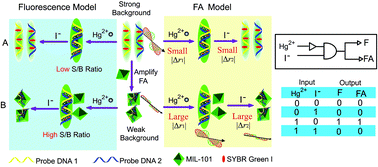A dual model logic gate for mercury and iodide ions sensing based on metal–organic framework MIL-101†
Abstract
Through the introduction of metal–organic framework MIL-101 as a low background signal and a fluorescence anisotropy amplification platform, a dual model DNA INHIBIT logic gate for Hg2+ and I− detection has been designed.


 Please wait while we load your content...
Please wait while we load your content...